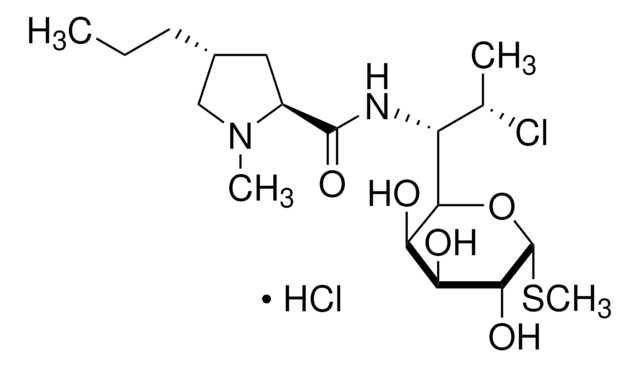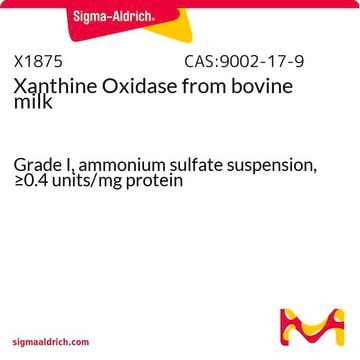Our general recommendations are as follows: Store at -20 °C (freezer) for up to six months. Store at 2-8 °C (refrigerator) for up to two weeks. Store at 20-25 °C (room temperature) for up to three days. According to J. Biol. Chem, 237, 2161-2174 (1962), cytochrome c is stable to boiling, and over an unusually wide range of pH values. However, it denatures readily at extreme pH (low or high), and in high concentrations of organic solvents, such as ethanol or acetone.
C7752
Citocromo c
≥95% based on Mol. Wt. 12,384 basis
Sinonimo/i:
Citocromo c
Scegli un formato
Scegli un formato
About This Item
Prodotti consigliati
Origine biologica
horse heart
Livello qualitativo
Saggio
≥95% (SDS-PAGE)
≥95% based on Mol. Wt. 12,384 basis
Stato
powder
PM
12,384
tecniche
cell culture | mammalian: suitable
Compatibilità
suitable for molecular biology
N° accesso UniProt
Temperatura di conservazione
−20°C
Informazioni sul gene
horse ... CYCS(100053958)
Cerchi prodotti simili? Visita Guida al confronto tra prodotti
Applicazioni
Il citocromo c è idoneo come componente del tampone fosfato per la rivelazione e la valutazione dell′attività del complesso IV mediante elettroforesi su gel di poliacrilammide blu nativo (BN-PAGE). Può anche essere usato per rivelare l′anione superossido extracellulare (ECSA) in fagociti isolati dal tessuto renale.
Azioni biochim/fisiol
Nota sulla preparazione
Altre note
Applicazioni
Comunemente ordinati con questo prodotto
Codice della classe di stoccaggio
11 - Combustible Solids
Classe di pericolosità dell'acqua (WGK)
WGK 3
Punto d’infiammabilità (°F)
Not applicable
Punto d’infiammabilità (°C)
Not applicable
Dispositivi di protezione individuale
Eyeshields, Gloves, type N95 (US)
Scegli una delle versioni più recenti:
Certificati d'analisi (COA)
Non trovi la versione di tuo interesse?
Se hai bisogno di una versione specifica, puoi cercare il certificato tramite il numero di lotto.
Possiedi già questo prodotto?
I documenti relativi ai prodotti acquistati recentemente sono disponibili nell’Archivio dei documenti.
I clienti hanno visto anche
Protocolli
Enzymatic Assay of Superoxide Dismutase
Chromatograms
application for HPLCapplication for HPLCapplication for HPLC-
How should I store solutions of Product C7752, Cytochrome c?
1 answer-
Helpful?
-
-
How do I determine how much of Product C7752, Cytochrome c, is in the oxidized form, and how much is reduced?
1 answer-
This is determined by a spectral assay. The detailed assay procedure (operating procedure #11252) may be requested from Sigma St. Louis Technical Service ([email protected]).
Helpful?
-
-
Is Product C7752, Cytochrome c, predominantly in the oxidized form or the reduced form?
1 answer-
This product is predominantly (>95%) in the oxidized form.
Helpful?
-
-
I see that you list several horse heart cytochrome c products. What are the differences, and which one should I choose?
1 answer-
Product No. C2506 is prepared with trichloroacetic acid (TCA), whereas C7752 is prepared with the milder acetic acid. The TCA method may reduce the amount of superoxide dismutase (SOD) present, but tends to cause dimerization or acid-modified structures of cytochrome c. In contrast, acetic acid preparations may have slightly higher amounts of SOD, but a lower proportion of dimeric cytochrome c. So C2506 would be recommended for enzyme activity studies that require low SOD, whereas C7752 is recommended for structural studies or binding studies, or for enzyme activity studies where possible SOD contamination is not a problem. Product No. C2867 is prepared from C2506; it is a BioUtra grade product, greater than or equal to 99% pure as determined by SDS-PAGE. It is recommended when an ultra-high purity is required. Product No. C3256 is also prepared from C7752; it is isolated by ion-exchange chromatography. This fraction shows a high rate of ascorbic acid oxidation, but low activity in a cytochrome oxidase system. Product No. C7150 is also prepared from C7752; it is suitable for use as a gel filtration molecular weight marker.
Helpful?
-
-
What is the Department of Transportation shipping information for this product?
1 answer-
Transportation information can be found in Section 14 of the product's (M)SDS.To access the shipping information for this material, use the link on the product detail page for the product.
Helpful?
-
Active Filters
Il team dei nostri ricercatori vanta grande esperienza in tutte le aree della ricerca quali Life Science, scienza dei materiali, sintesi chimica, cromatografia, discipline analitiche, ecc..
Contatta l'Assistenza Tecnica.







